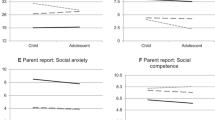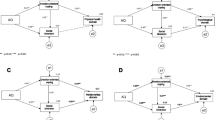Abstract
Traits associated with autism, along with depression, anxiety, loneliness, quality of life, and social anxiety were investigated by self-report questionnaires in a university student population (N = 413). In the sample, which was recruited online, 8 % had scores above cut-off on the Autism Spectrum Quotient (AQ) self-report questionnaire. There were significant differences in AQ between students studying physical sciences and both social sciences and arts/humanities. Higher AQ scores were associated with higher scores of loneliness, social anxiety, depression, and anxiety, as well as with lower scores of quality of life (QoL). QoL was best predicted for by scores of depression, loneliness, and social anxiety; the latter two variables mediated the relationship between autism traits and QoL. The identification and support of such students who may be vulnerable is of utmost importance.


Similar content being viewed by others
References
Aigner, M., Förster-Streffleur, S., Prause, W., Freidl, M., Weiss, M., & Bach, M. (2006). What does the WHOQOL-Bref measure? Social Psychiatry and Psychiatric Epidemiology, 41(1), 81–86.
American Psychiatric Association (2013). Diagnostic and Statistical Manual of Mental Disorders (5th ed.). Arlington, VA: American Psychiatric Publishing.
Baron-Cohen, S., Wheelwright, S., Skinner, R., Martin, J., & Clubley, E. (2001). The autism-spectrum quotient (AQ): Evidence from asperger syndrome/high-functioning autism, males and females, scientists and mathematicians. Journal of Autism and Developmental Disorders, 31(1), 5–17.
Baron-Cohen, S., Wheelwright, S., Burtenshaw, A., & Hobson, E. (2007). Mathematical talent is linked to autism. Human Nature, 18(2), 125–131.
Berman, W. H., & Sperling, M. B. (1991). Parental attachment and emotional distress in the transition to college. Journal of Youth and Adolescence, 20(4), 427–440.
Bishop, D. V., Maybery, M., Maley, A., Wong, D., Hill, W., & Hallmayer, J. (2004). Using self-report to identify the broad phenotype in parents of children with autistic spectrum disorders: a study using the Autism-Spectrum Quotient. Journal of Child Psychology and Psychiatry, 45(8), 1431–1436.
Bjelland, I., Dahl, A. A., Haug, T. T., & Neckelmann, D. (2002). The validity of the Hospital Anxiety and Depression Scale: an updated literature review. Journal of Psychosomatic Research, 52(2), 69–77.
Freeth, M., Bullock, T., & Milne, E. (2013). The distribution of and relationship between autistic traits and social anxiety in a UK student population. Autism, 17(5), 571–581.
Ghaziuddin, M., Weidmer-Mikhail, E., & Ghaziuddin, N. (1998). Comorbidity of Asperger syndrome: a preliminary report. Journal of Intellectual Disability Research, 42(4), 279–283.
Glennon, T. J. (2001). The stress of the university experience for students with Asperger syndrome. Work: A Journal of Prevention, Assessment and Rehabilitation, 17(3), 183–190.
Happé, F., & Ronald, A. (2008). The ‘fractionable autism triad’: a review of evidence from behavioural, genetic, cognitive and neural research. Neuropsychology Review, 18(4), 287–304.
Hurley, R. S., Losh, M., Parlier, M., Reznick, J. S., & Piven, J. (2007). The broad autism phenotype questionnaire. Journal of Autism and Developmental Disorders, 37(9), 1679–1690.
Ingersoll, B., Hopwood, C. J., Wainer, A., & Donnellan, M. B. (2011). A comparison of three self-report measures of the broader autism phenotype in a non-clinical sample. Journal of Autism and Developmental Disorders, 41(12), 1646–1657.
Jobe, L. E., & Williams White, S. (2007). Loneliness, social relationships, and a broader autism phenotype in college students. Personality and Individual Differences, 42(8), 1479–1489.
Jones, W. H., Hobbs, S. A., & Hockenbury, D. (1982). Loneliness and social skill deficits. Journal of Personality and Social Psychology, 42(4), 682.
Krägeloh, C. U., Henning, M. A., Hawken, S. J., Zhao, Y., Shepherd, D., & Billington, R. (2011). Validation of the WHOQOL-BREF quality of life questionnaire for use with medical students. Education and Health, 24(2), 545.
Kunihira, Y., Senju, A., Dairoku, H., Wakabayashi, A., & Hasegawa, T. (2006). ‘Autistic’traits in non-autistic Japanese populations: relationships with personality traits and cognitive ability. Journal of Autism and Developmental Disorders, 36(4), 553–566.
Lee, L. C., Harrington, R. A., Louie, B. B., & Newschaffer, C. J. (2008). Children with autism: quality of life and parental concerns. Journal of Autism and Developmental Disorders, 38(6), 1147–1160.
Liebowitz, M. R. (1987). Social phobia. In D. F. Klein (Ed.), Anxiety (pp. 141–173). New York: Karger Publishers.
MacKinnon, D. P., Lockwood, C. M., & Williams, J. (2004). Confidence limits for the indirect effect: Distribution of the product and resampling methods. Multivariate Behavioral Research, 39(1), 99–128.
Piven, J., & Palmer, P. (1999). Psychiatric disorder and the broad autism phenotype: evidence from a family study of multiple-incidence autism families. American Journal of Psychiatry, 156(4), 557–563.
Preacher, K. J., & Hayes, A. F. (2004). SPSS and SAS procedures for estimating indirect effects in simple mediation models. Behavior Research Methods, Iinstruments, & Computers, 36(4), 717–731.
Russell, D. W. (1996). UCLA Loneliness Scale (Version 3): Reliability, validity, and factor structure. Journal of Personality Assessment, 66(1), 20–40.
Russell, D., Peplau, L. A., & Cutrona, C. E. (1980). The revised UCLA Loneliness Scale: Concurrent and discriminant validity evidence. Journal of Personality and Social Psychology, 39(3), 472–480.
Rytwinski, N. K., Fresco, D. M., Heimberg, R. G., Coles, M. E., Liebowitz, M. R., Cissell, S., & Hofmann, S. G. (2009). Screening for social anxiety disorder with the self-report version of the Liebowitz Social Anxiety Scale. Depression and Anxiety, 26(1), 34–38.
Sandstrom, M. J., & Zakriski, A. L. (2004). Understanding the experience of peer rejection. In J. B. Kupersmidt & K. Dodge (Eds.), Children’s peer relations (pp. 101–118). Washington, DC: American Psychological Association.
Sasson, N. J., Nowlin, R. B., & Pinkham, A. E. (2013). Social cognition, social skill, and the broad autism phenotype. Autism, 17(6), 655–667.
The World Health Organisation (1994). Development of the WHOQOL: rationale and current status. International Journal of Mental Health, 23, 24–56.
The World Health Organisation (1998). The World Health Organization Quality of Life assessment (WHOQOL): Development and general psychometric properties. Social Science and Medicine, 46, 1569–1585.
Van Ameringen, M., Mancini, C., & Farvolden, P. (2003). The impact of anxiety disorders on educational achievement. Journal of Anxiety Disorders, 17(5), 561–571.
VanBergeijk, E., Klin, A., & Volkmar, F. (2008). Supporting more able students on the autism spectrum: College and beyond. Journal of Autism and Developmental Disorders, 38(7), 1359–1370.
Volkmar, F. R., Lord, C., Bailey, A., Schultz, R. T., & Klin, A. (2004). Autism and pervasive developmental disorders. Journal of Child Psychology and Psychiatry, 45(1), 135–170.
White, S. W., Ollendick, T. H., & Bray, B. C. (2011). College students on the autism spectrum: Prevalence and associated problems. Autism, 15, 783–801.
Whitehouse, A. J., Durkin, K., Jaquet, E., & Ziatas, K. (2009). Friendship, loneliness and depression in adolescents with Asperger's Syndrome. Journal of Adolescence, 32(2), 309–322.
Zigmond, A. S., & Snaith, R. P. (1983). The hospital anxiety and depression scale. Acta Psychiatrica Scandinavica, 67(6), 361–370.
Author information
Authors and Affiliations
Corresponding author
Ethics declarations
Ethical Approval
All procedures performed in studies involving human participants were in accordance with the ethical standards of the institutional and/or national research committee and with the 1964 Helsinki declaration and its later amendments or comparable ethical standards. The research was given ethical review and approval by the Ethics Committee of the Psychology Department of the University.
Informed Consent
All participants were given information about the study prior to commencing, informed of the right to withdraw at any time, and indicated consent by clicking a consent button on the survey.
Conflict of Interest
There were no potential conflicts of interest for any author.
Rights and permissions
About this article
Cite this article
Reed, P., Giles, A., Gavin, M. et al. Loneliness and Social Anxiety Mediate the Relationship between Autism Quotient and Quality of Life in University Students. J Dev Phys Disabil 28, 723–733 (2016). https://doi.org/10.1007/s10882-016-9504-2
Published:
Issue Date:
DOI: https://doi.org/10.1007/s10882-016-9504-2




